Overview of species and popular varieties of fir

The decorative merits of fir have long been appreciated by gardeners and designers. It is often used to decorate urban areas and home gardens due to its many species and varieties.
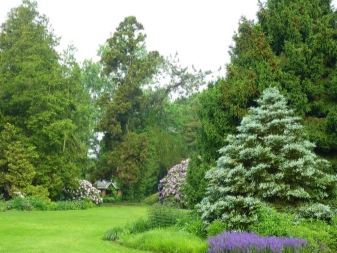
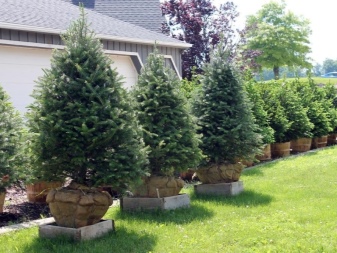
General characteristics
Fir, being a relative of spruce, belongs to the genus gymnosperms from the Pine family. It is an evergreen monoecious plant. Its habitat is unusually wide: temperate, subtropical and tropical climatic zones of the northern hemisphere, which includes some countries of Central America.
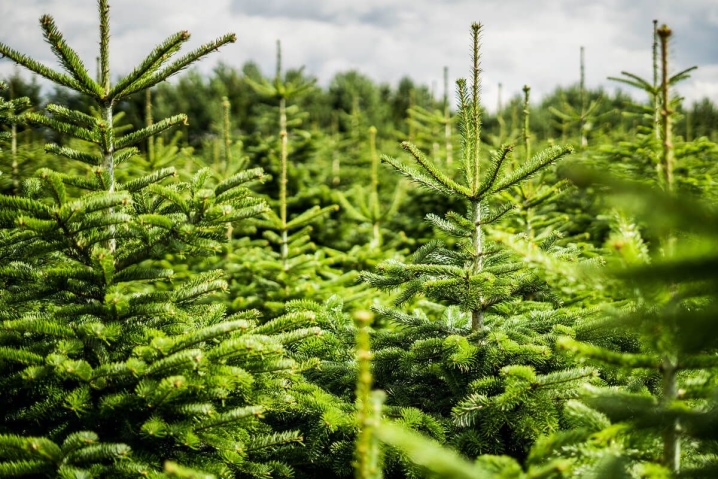
The fir is a powerful and long-lived tree with a pyramid-shaped crown., which is formed by horizontal spiral ringed skeletal branches. The crown begins very low - at the base. Its trunk is straight and high, reaching 60-80 m, and its diameter can be 3.5 m.

Young trees have smooth and thin gray bark, which is cut with resin passages, which leads to the formation of outgrowths and the appearance of thickenings on its surface.
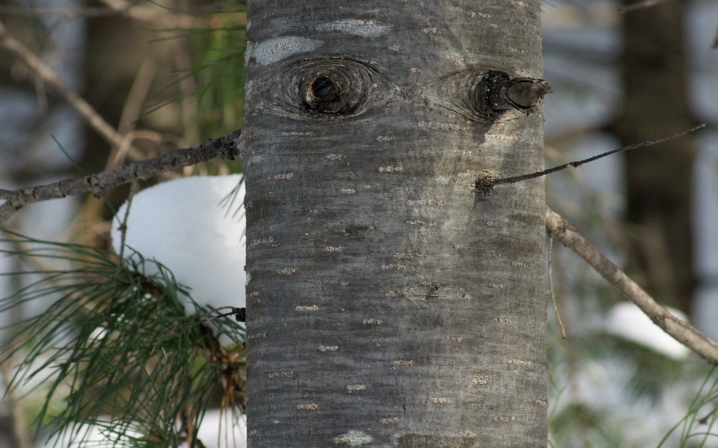
As the fir ages, the bark becomes thicker and, cracking, forms deep cracks.
The branches are very dense, and the shoots growing in a spiral form 1 turn annually. The needles look like flat needles, which become narrow at the base, forming a small petiole. He, bending on 2 planes, straightens the needles on the branches and gives it a comb-like appearance.
The needles live and do not fall off for many years. It is also located on the branches in a spiral. Needles with blunt ends 5-8 cm long and about 3 mm wide grow singly and have a rich green, occasionally silvery-bluish color, and on the underside there are two white stripes.
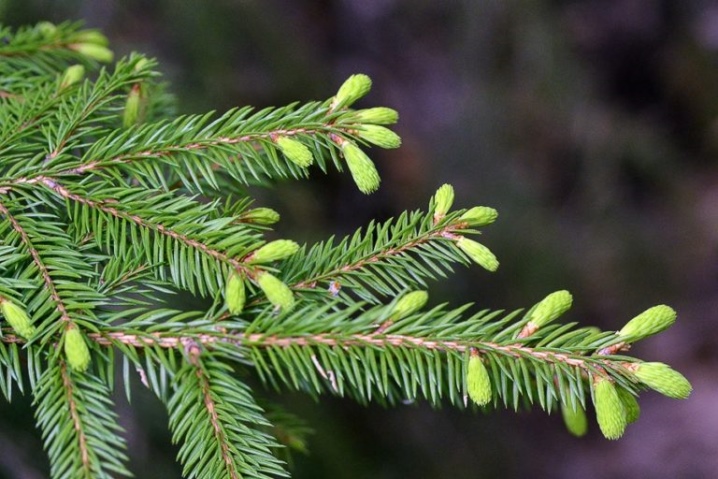
The arrangement of needles on branches can be of 3 types:
- the needles have an upward growth direction (like bristles on a brush);
- the needles are arranged in a circle (like a brush);
- the needles grow symmetrically - usually such needles are on the lateral processes. Even on the same fir, different types of needles can be found.
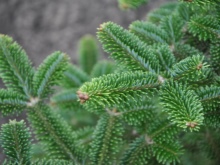
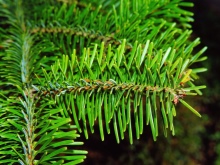

Since the fir is a monoecious plant, it blooms flowers of 2 types - male and female. Male ones grow in several pieces, making up a group of cones that resemble earrings. They contain a lot of pollen, which is why they have a yellowish or reddish tint. In the spring, after opening, they release pollen and then fall off.
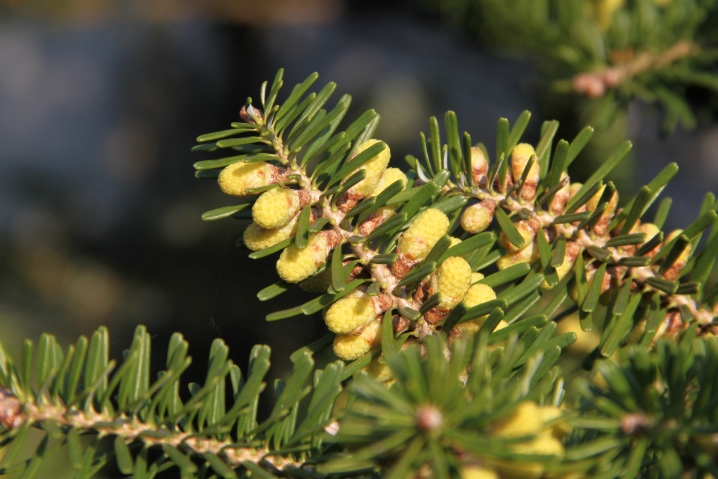
The flowers are female, from 3 to 11 cm long, have an ovoid or cylindrical shape and grow strictly vertically, resembling candles. They consist of a rod with covering scales sitting on it, inside of which are fruit scales with 2 ovules. At first they have a violet-pink tone, but as they mature, the hardening scales turn brown.
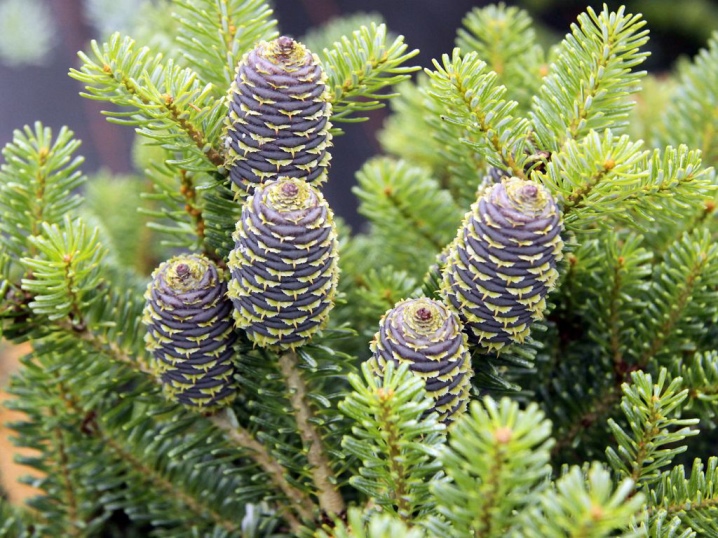
By autumn, medium-sized seeds with wings ripen. After their ripening, the scales, having become wood, fall off, the seeds are released and spread. Only rods remain on the branches.

Fir begins to bloom at about 30 years of age. On average, fir lives from 300 to 500 years.
Description of species
Since the fir has a wide geographical distribution, there are many of its species. There are more than 50 of them, and 8 of its varieties grow in Russia in natural conditions.
Sakhalin fir
Its distribution area is the south of Sakhalin and the Kuril Islands, where it grows in wooded mountain areas. The tree is distinguished by its decorative appearance: the crown has the shape of a regular cone with soft needles, which have blunt needles. The bark is smooth.
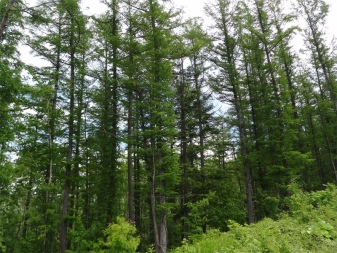
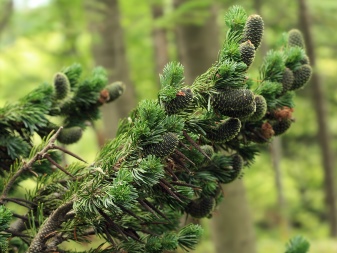
Elliptical cones reach 7 cm.The seeds are brown or yellow with purple wings.
Siberian fir (northern)
In the Urals, only this type of fir grows, therefore it is also called the Ural fir. However, its distribution is much wider and covers the northeastern and Siberian territories of Russia, the Far East. Siberian is the northernmost fir, growing even beyond the Arctic Circle.
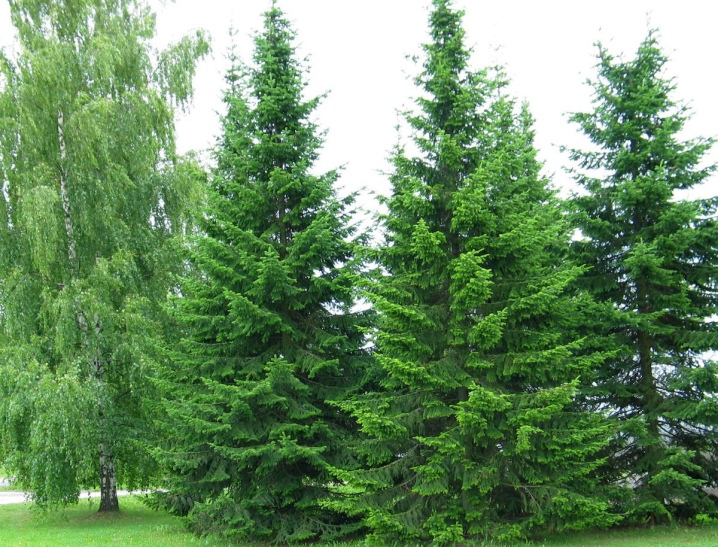
Its maximum height is about 30 m. The trunk is covered with smooth dark gray bark, which does not crack with age. On the bark, thickenings with a transparent resin (sap) are visible.
The fir retains its crown in the form of a narrow pyramid, almost columnar, all its life. The branches on the trunk grow very low. Thornless flat shiny needles of deep green color have 2 whitish stripes on the inner side of the needles. Their length is about 3.5 cm. The needles have a characteristic aroma.
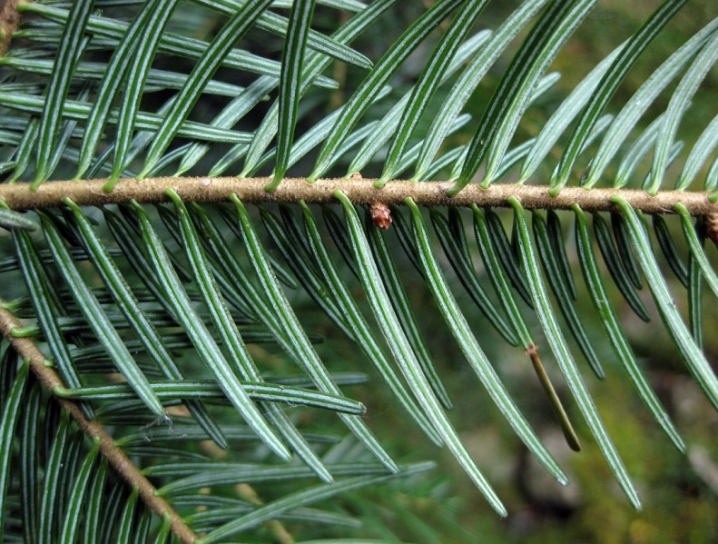
Fir begins to bloom only after reaching 70 years of age. It blooms in spring, and the seeds ripen by early autumn. Lives for a long time, almost 200 years. It has a high wind and frost resistance, however, it reacts negatively to smoke and gas pollution, which makes it unsuitable for growing in urban conditions.
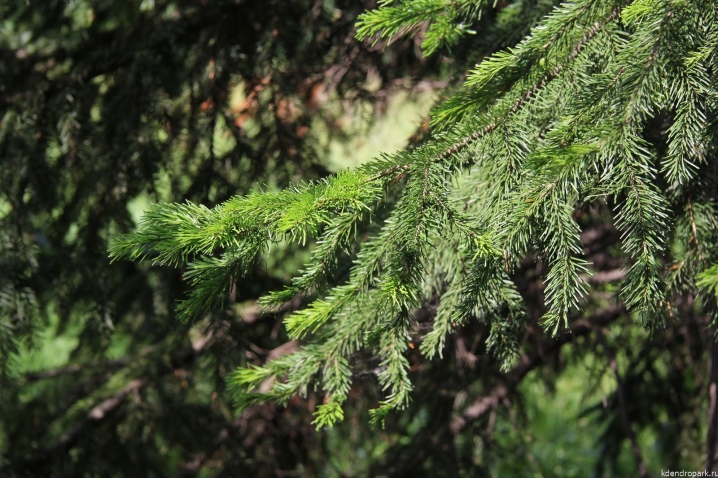
Korean fir
In Russia, this species is also called Chinese or Karelian fir. Chinese - due to the close proximity of Korea (the homeland of the species) to China. And they call it Korean, confusing it with the Karelian pine.

The tree is slow growing. It often happens that the width of the crown exceeds its height. By the age of 30, it can only reach 3-4 m, and the maximum height is about 15 m.
Dense short (1-1.5 cm) needles of a juicy green shade from below are painted white. It is distinguished by its splendor, surface rigidity and saber-like shape.
The rough bark of a young tree is painted in a light gray color, eventually acquiring a brownish-red and even crimson hue.
A distinctive feature of the tree is its cones: fir comes with blue, blue cones, which, as they mature, acquire a purple-crimson and then brown color. Cones are in the form of a cylinder, about 5-7 cm long. They can appear even on a 7-8 year old fir.

Vicha fir
Japan is considered the homeland of this species. A characteristic feature of the tree is its decorative crown, formed by unusually hanging branches covered with soft bent needles.
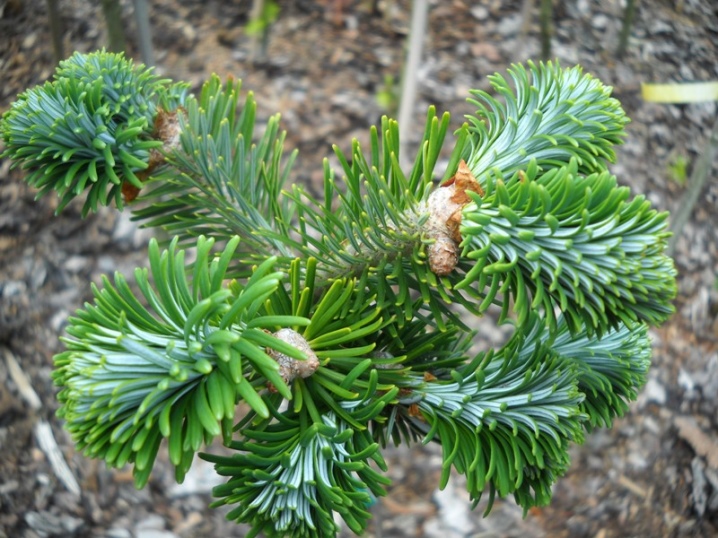
In Russia, it grows in nature in the Far East in the form of fir forests or together with other conifers.
In young years, it grows quite quickly and by the age of 30 it can reach 8 m.The maximum height of a fir is up to 35 m, the trunk girth is from 0.3 to 0.5 m.
This fir changes the shape of the crown over the years of growth. In the early years, it has a shape in the form of a narrow pyramid, which later, developing, forms a wide pillar.
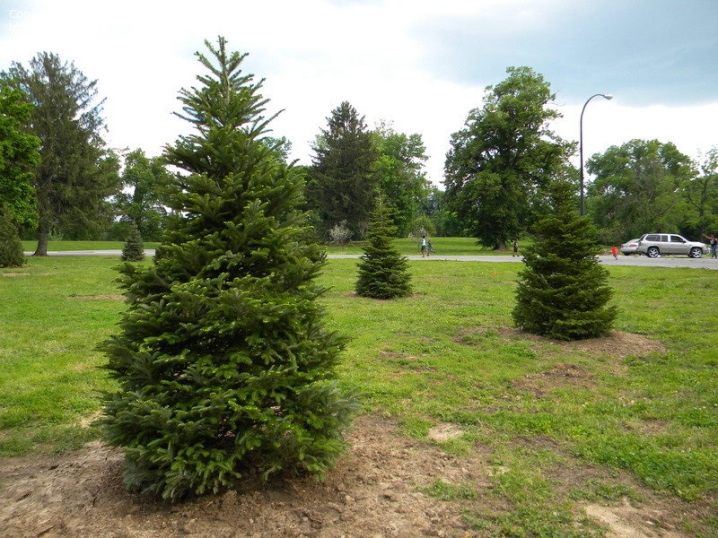
The needles of the needles grow vertically with a slight slope, which allows you to see their inner surface with a whitish bloom. The needles are lush and soft. The smooth bark has a gray color, which can be greenish on young shoots.
Cones are cylindrical in shape and 4-7 cm long, slightly tapering towards the apex. Colored in purple tones with a violet sheen, they become brown when ripe.

Fir is a long-liver: it can live up to 300 years. Of all other tree species, this variety stands out for its high resistance to adverse conditions.
White fir
In our country, this species grows in the Amur Region, in Primorsky and in the southern regions of the Khabarovsk Territory. The white-brown variety grows up to 30 m in height. It features a narrow, symmetrical, cone-shaped crown.
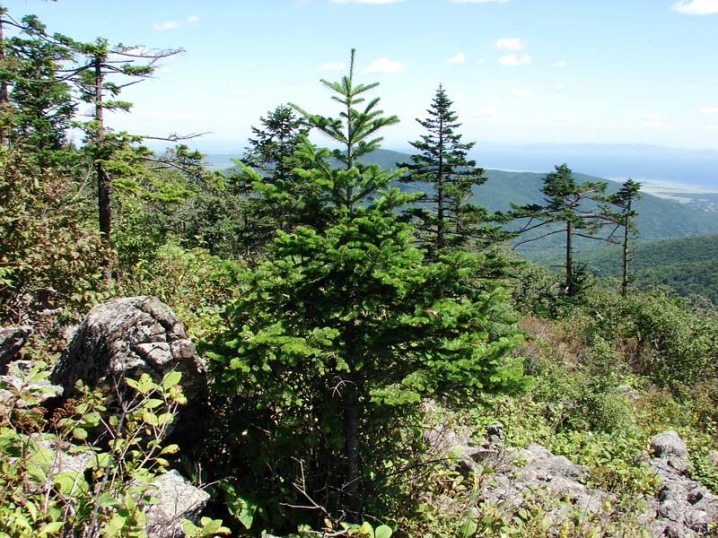
The smooth bark on the branches is gray with a silvery shade, which is reflected in its name. Seals with transparent resin are clearly visible on the barrel. The bark of an adult tree gradually darkens.
Soft, short (from 1 to 3 cm) needles 1.5-2 mm wide have slightly bifurcated pointed tips and are painted in a dense green color with whitish stripes at the base.In cylindrical cones 4.5-5.5 cm long, the color is first purple, then dark brown.

The tree reaches 30 m, the girth of the trunk can be from 35 to 50 cm. The fir is rather fast growing and lives for about 150-180 years.
Common or European white fir
Distributed in the countries of Southern and Central Europe. On average, it lives up to 350-400 years. This is a rather powerful tree, the height of which reaches 50-60m, the crown width is up to 8m, and the trunk diameter is up to 1.9m.
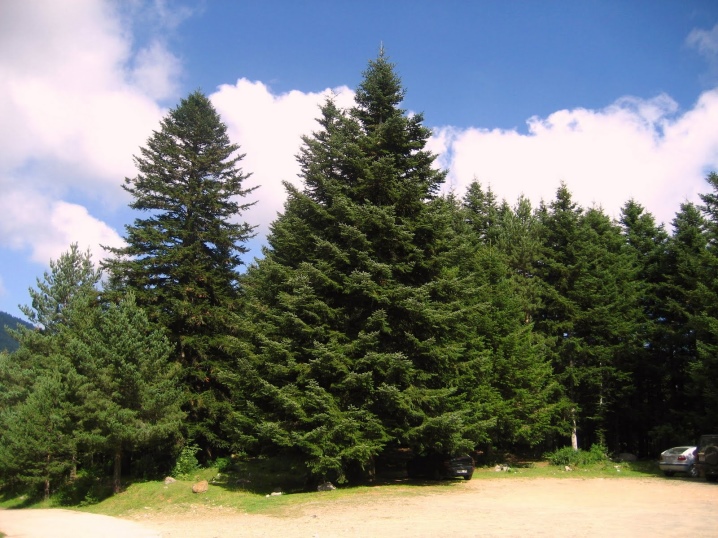
The smooth bark is colored in light gray tones, occasionally with a red tint. Over time, it cracks on the bottom of the trunk. Short needles (up to 2.5 cm) have a deep green color with 2 white stripes on the inner surface.
Cones appear at the age of 25-30. They have a cylindrical shape with a rounded top, their size is from 10 to 16 cm, and they emit resin. The buds are green at first and then dark brown.
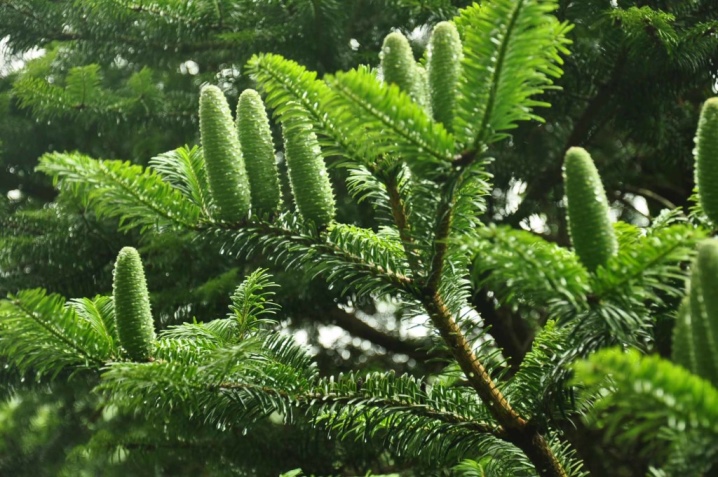
Spanish
In nature, it is widely distributed in the south of Spain. A coniferous tree, reaching 25 meters in height, is characterized by a low-growing crown in the form of a pyramid. The trunk, covered with rough bark, can be 1 m in diameter.
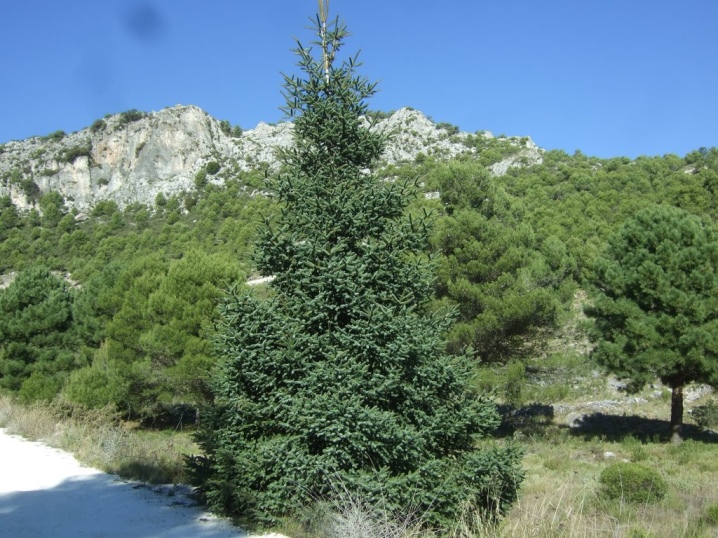
The needles of tough and thick needles can be sharp or blunt. They are 1-1.5 cm long and grow evenly in different directions. At the needles, the outer surface is slightly convex, and on the inner one, 2 dull whitish stripes are visible, giving all the needles a gray-green tint.
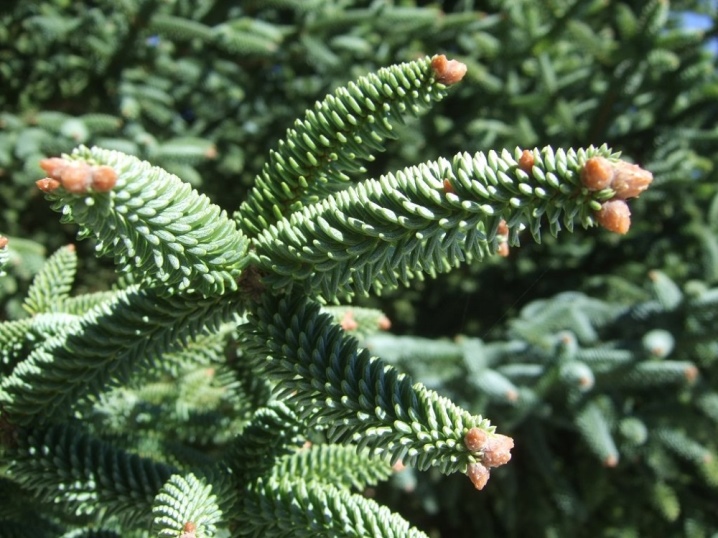
The crown has a wide conical shape and is lowered low. In young firs, the bark is smooth, while in adults it is cracked and painted in a dark gray shade.
Flowering occurs in mid-spring (April). Cones about 15 cm long and up to 5 cm thick have a cylindrical shape with a rounded top. Young buds are purple or green with a pink or whitish bloom.
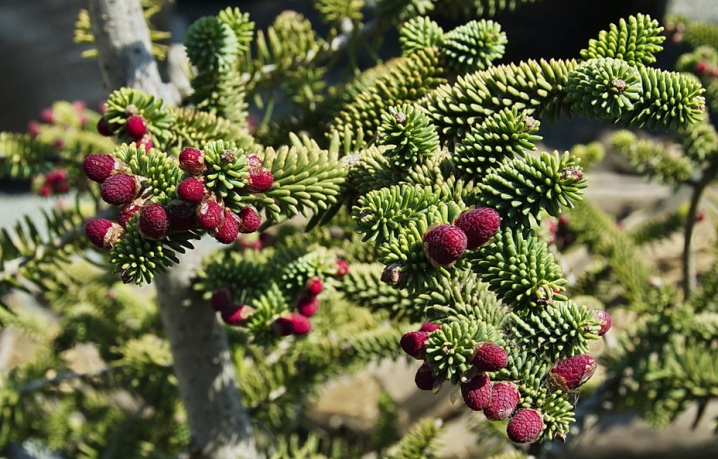
Ripening of dark brown seeds with beige wings occurs in October.
Numidian
This fir is native to the Algerian Kabyle Mountains. A massive tree with a dense crown in the form of a regular cone, reaches 15-20 m in height. The needles are green on the outside, and there are 2 silver stripes on the underside. The needles are short and flat, tough, but not prickly, growing densely and densely along the entire length of the branch.

The size of the needles is 1.5-2.5 cm in length and about 2.5 mm in width. Resinous cones of a gray-brown hue have an elongated-cylindrical shape with a blunt end and a length of 12 to 20 cm.
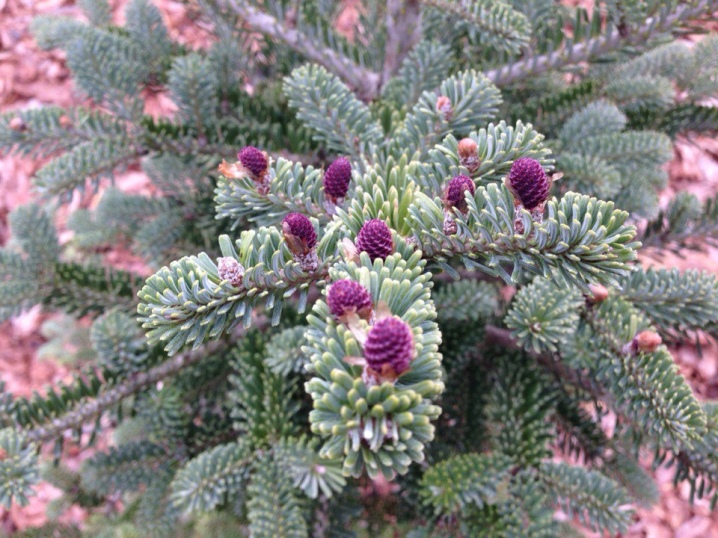
Young plants have smooth, gray bark. The old crust becomes dark brown, bursts, forming longitudinal cracks in the form of grooves. Naked and thick young shoots are first colored green with a yellowish tinge, later turning brown or reddish-brown.
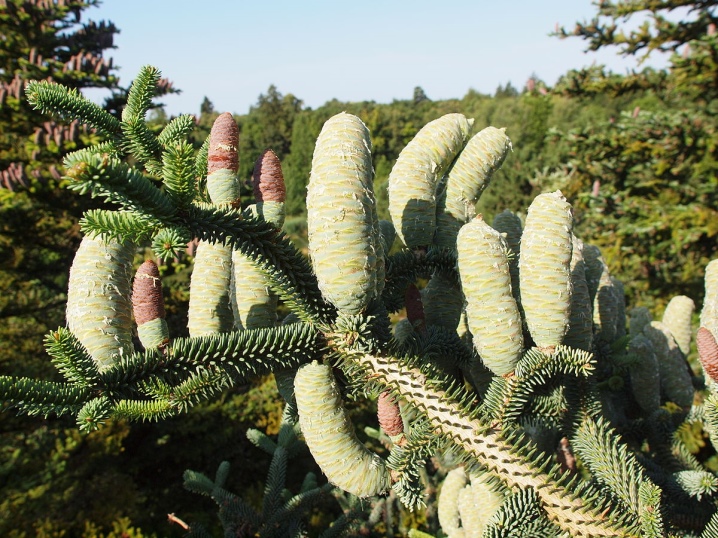
Canadian
North America is considered the homeland of the species. Fir has a beautiful dense symmetrical crown in the form of a cone, and sometimes in the form of a narrow pyramid. The branches of the plant grow singly and slope low to the soil.
Young trees have light gray bark, which turns brown with a red tint with age. On the young bark, thickenings containing resin are visible, which eventually burst and form cracks and cracks. Resin is released from them.
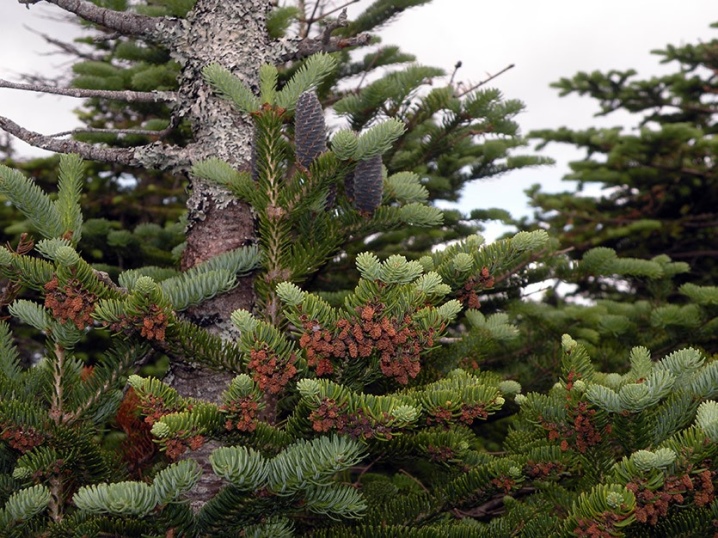
This feature has become the reason for another name - balsam fir.
The needles are flat with rounded tips and are soft. The length of the needles is on average 2-3.5 cm, the width is 2 mm. Outside, the needles are deep green, and the lower surface has a bluish tint and 2 white stripes. The needles are vertically directed and grow on the branches in a spiral.
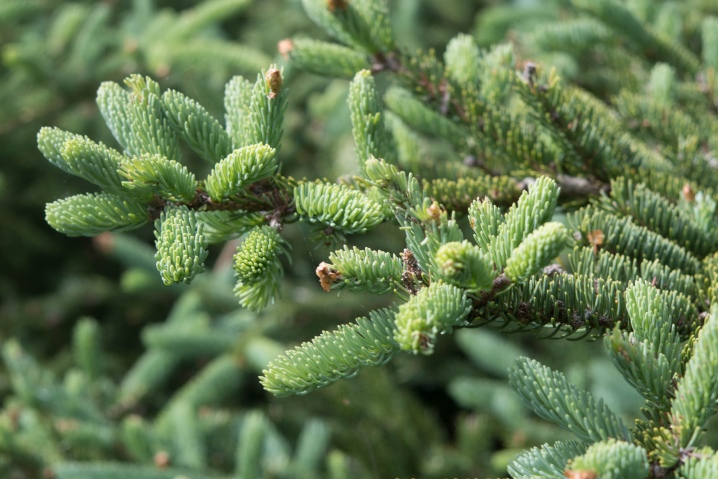
Young pubescent shoots have a green color, acquiring a brown tint over time. The length of the cones is from 5 to 10 cm, at first they are colored dark purple, then turning brown.
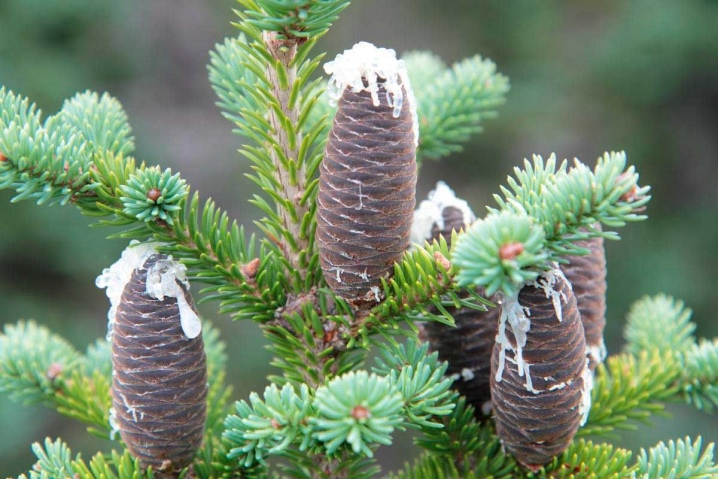
For the first 10 years, the plant is characterized by slow growth, and after that it begins to grow faster. The maximum height is 20-25 m, the trunk width is about 70 cm.
In addition to these types, there are others.
- Whole-leaved fir (black Manchurian). A distinctive feature of this species is the color of the bark: in a young fir it is dark gray, and in an adult it is black.
- Tall fir, reaching a height of 100 m.
- Pretty, with needles that smell of orange.
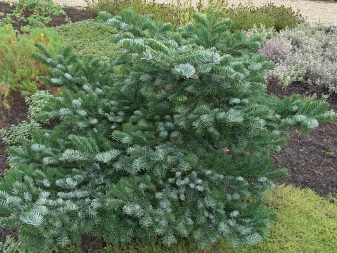
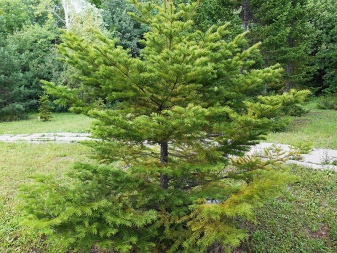
There are also such species: fir of Vetkhov, Fraser, Caucasian, subalpine, Greek and others.
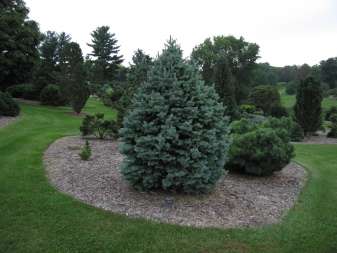
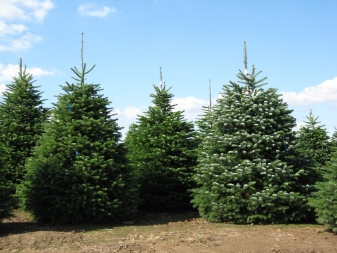
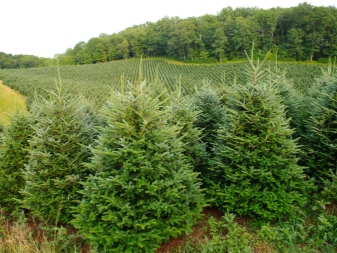
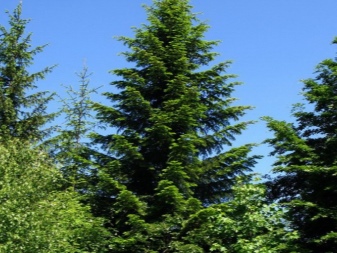
Review of popular varieties
Fir of different species have many different breeding varieties, differing in color of needles, crown shape and dimensions. For landscape design, undersized and dwarf varieties are of greatest interest. The most commonly used varieties are with such names.
"Nana"
"Nana" refers to the Canadian (balsamic) species. It is a small, low shrub with open branches and slow growth. For 10 years of life, the height, as well as the width, reaches only 0.5 m. The maximum dimensions of an adult plant are 0.8-1 m in height and about 2.5 m in width.
"Nana" is distinguished by its original crown: it has a flat-rounded shape formed by short horizontal branches growing chaotically and densely. Very short (no more than 1 cm) lush needles of an unusual bright green emerald color grows on the shoots with a deviation downward.
On young processes, the needles are located radiantly, and on old ones, they are comb-like with a clear division. On the underside of the needles, 2 white-blue stripes are clearly visible.
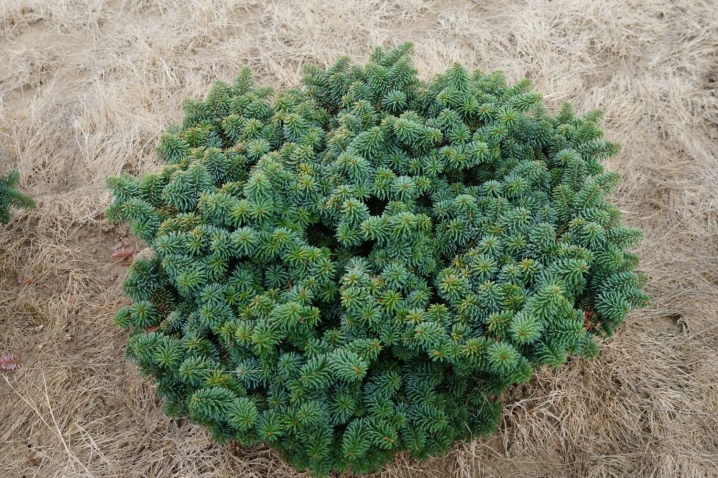
The variety is picky about the soil and prefers fertile land, loves moisture and does not tolerate heat and drought.
"Piccolo"
"Piccolo" is also a balsam fir. It belongs to dwarf varieties, has a beautiful round crown. It is characterized by slow growth, and the growth gives mainly in width: by the age of 10, the crown height reaches about 0.3 m, and the width can be 1.5 m.
The main stem of the bush is not pronounced; it bends to the ground in the same way as the open, lowered branches. The needles are short, thick and lush. A distinctive feature of the variety is the contrast in the color of the needles: the young one has a delicate light green shade, and the old needles have a thick, rich green color. Coniferous needles with blunt tips sit on branches with a slight downward slope, close to each other.
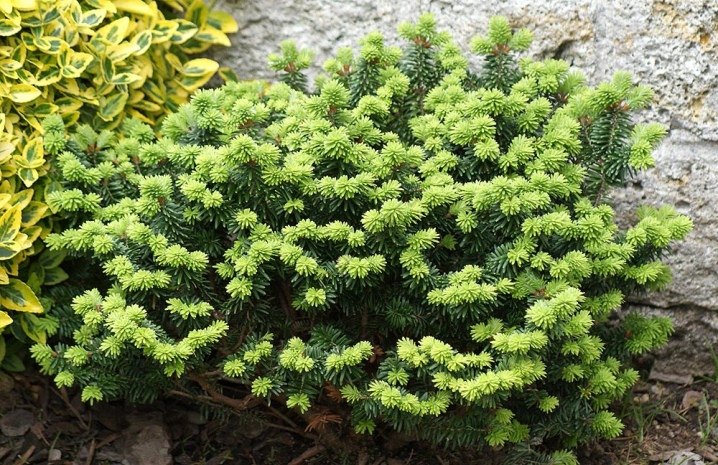
Prefers fertile land, reacts negatively to stagnant water, heat and drought.
"Pendula"
"Pendula" is a representative of the Vich fir. An ornamental variety with purple cones, which are initially blue with a reddish tint, gradually turning into purple. The soft but dense needles have a shiny outer side of a thick green color, and the inner one is silvery due to 2 whitish stripes.
The fir is distinguished by its graceful crown shape, formed by low-hanging branches. By the age of 10, it can grow up to 2.5 m.

"Green Carpet"
"Green Carpet" refers to the Korean species. It is a low semi-dwarf variety. The bush does not have a central trunk, and the branches are widely spread to the sides. Young trees have a crown in the form of a wide pyramid, which over time acquires a more uniform and regular shape.
Tough and shiny needles up to 2 cm long are distinguished by a bright green color with a silvery inner side. The growth per year is about 10 cm, and by the age of 10, the fir can reach 1 m with a crown width of 2 m.
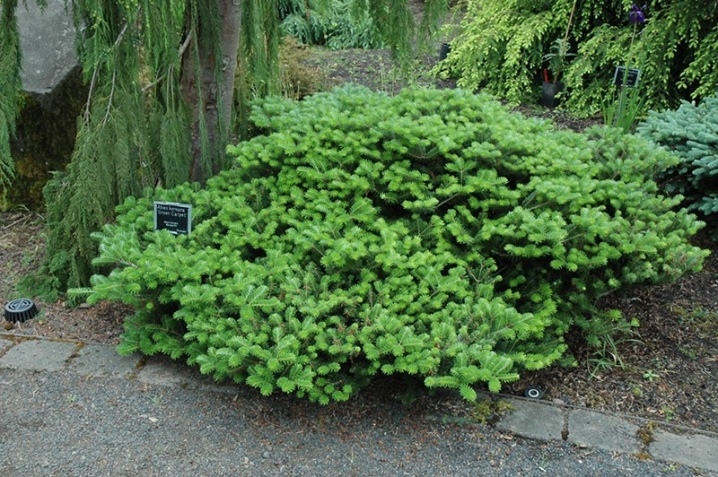
"Icebreaker"
Icebreaker is another Korean fir variety, which is distinguished by its miniature size. But its characteristic feature is the needles, which are turned outward with the underside of the silver color. This creates the impression that the crown is sprinkled with small pieces of ice.
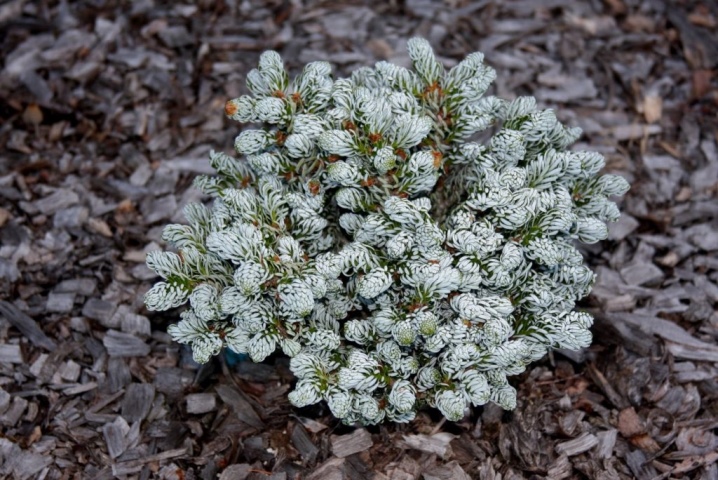
It grows slowly, adding only up to 3 cm annually. At 10 years old, the dimensions can be as follows: height - 25-30 cm, crown width - up to 50 cm, and maximum dimensions - 80 cm and 1.2 m, respectively.
"Oberon"
"Oberon" is a Korean fir. A miniature bush with a rounded crown, over time, acquires the shape of an irregular cone. Short and even shiny needles, growing in a spiral, are painted in a rich green shade. In the spring, the fir is adorned with purple cones.
It grows slowly, adding no more than 5-7 cm annually.At the age of 10, it reaches a height of 0.3-0.4 m.
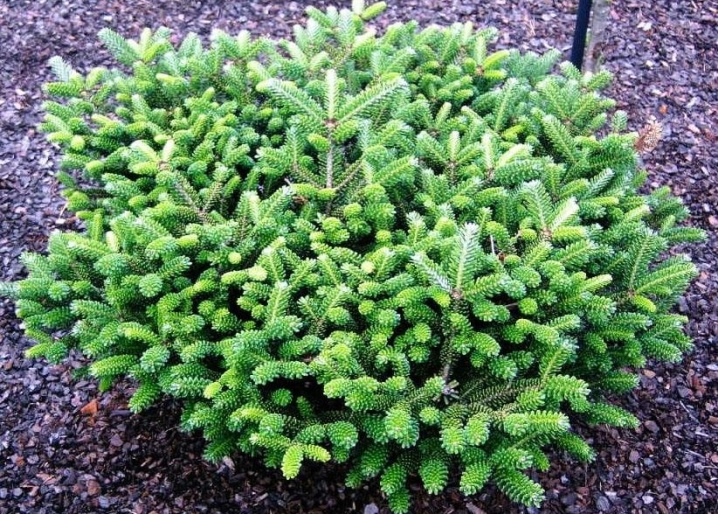
Selection Tips
When choosing a fir, first of all, it should be remembered that it does not tolerate the polluted urban atmosphere well and it is preferable to grow it outside the city. Tall varieties of one-color fir are more suitable for the city.
To decorate personal plots, stunted and dwarf varieties are most often chosen. When choosing a fir, it is also necessary to take into account the function that it will perform: decorate the general background of the territory, visually emphasize other plants or decorate a hedge. The shape and size of the tree depends on this.
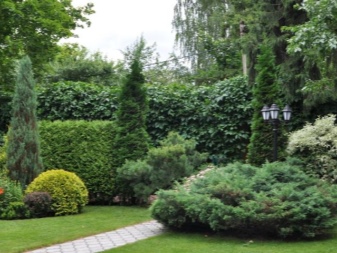
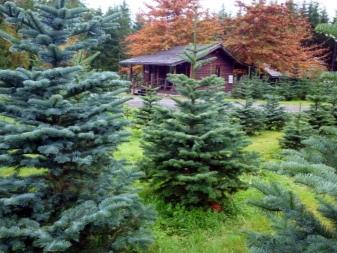
High varieties of fir are chosen for the design of hedges, undersized varieties - to create a background for flowering plants, and dwarf ones - to decorate compositions with perennial plants and decorate small gardens and large areas.
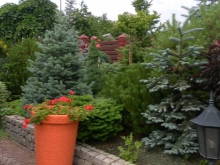

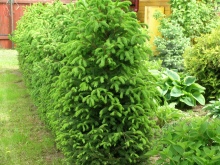
The color of the needles is chosen depending on the combination of its color with other flowering perennials or on the preferences of the gardener.
Tall trees look good if they grow in isolation, while low trees look good in group plantings. For the decoration of alpine slides, it is better to choose dwarf varieties, and undersized ones with falling branches look great in Japanese gardens. The rounded shapes of fir are often used to decorate rockeries. In group plantings, fir ideally coexists with decorative deciduous shrubs and brightly flowering plants.
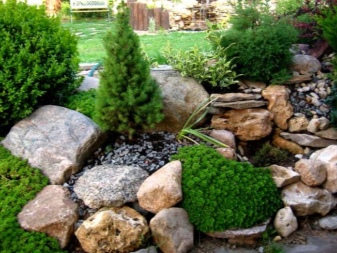
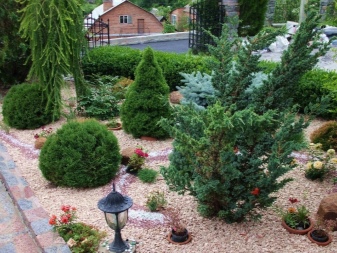
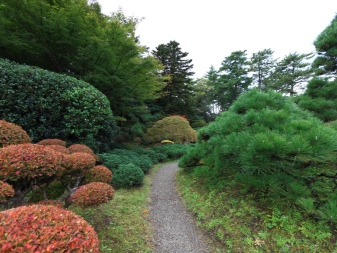
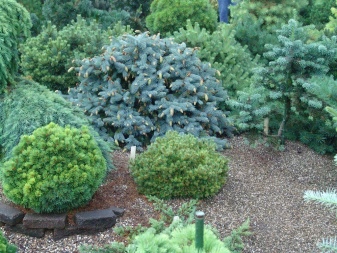
For information on how to properly plant and care for fir, see the video below.































































The comment was sent successfully.